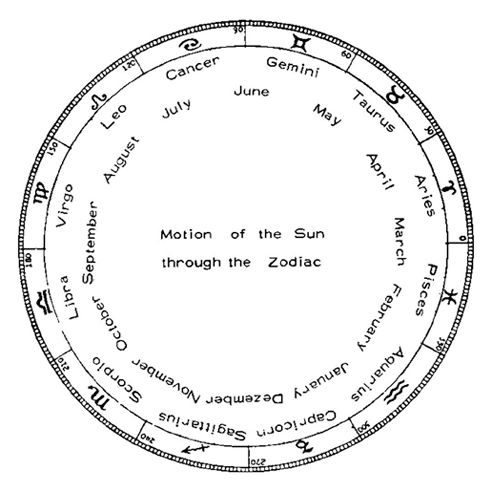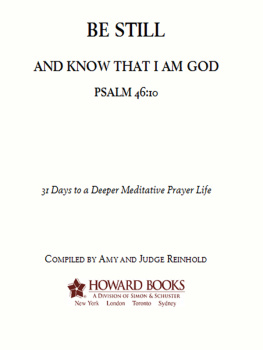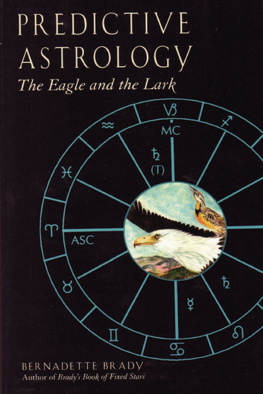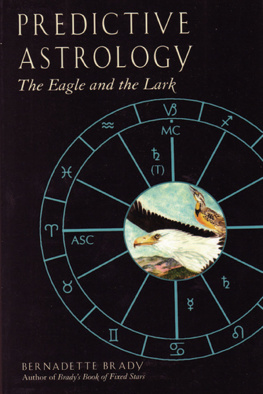Reinhold Ebertin - Transits: What Days Favor You?
Here you can read online Reinhold Ebertin - Transits: What Days Favor You? full text of the book (entire story) in english for free. Download pdf and epub, get meaning, cover and reviews about this ebook. year: 2015, publisher: American Federation of Astrologers, genre: Science fiction / Religion. Description of the work, (preface) as well as reviews are available. Best literature library LitArk.com created for fans of good reading and offers a wide selection of genres:
Romance novel
Science fiction
Adventure
Detective
Science
History
Home and family
Prose
Art
Politics
Computer
Non-fiction
Religion
Business
Children
Humor
Choose a favorite category and find really read worthwhile books. Enjoy immersion in the world of imagination, feel the emotions of the characters or learn something new for yourself, make an fascinating discovery.
- Book:Transits: What Days Favor You?
- Author:
- Publisher:American Federation of Astrologers
- Genre:
- Year:2015
- Rating:5 / 5
- Favourites:Add to favourites
- Your mark:
- 100
- 1
- 2
- 3
- 4
- 5
Transits: What Days Favor You?: summary, description and annotation
We offer to read an annotation, description, summary or preface (depends on what the author of the book "Transits: What Days Favor You?" wrote himself). If you haven't found the necessary information about the book — write in the comments, we will try to find it.
Transits: What Days Favor You? — read online for free the complete book (whole text) full work
Below is the text of the book, divided by pages. System saving the place of the last page read, allows you to conveniently read the book "Transits: What Days Favor You?" online for free, without having to search again every time where you left off. Put a bookmark, and you can go to the page where you finished reading at any time.
Font size:
Interval:
Bookmark:
Transits: What Days Favor You?
Reinhold Ebertin
Copyright 1991 by Reinhold Ebertin
All rights reserved.
No part of this book may be reproduced or transmitted in any form or by any means, electronic or mechanical, including photocopying or recording, or by any information storage and retrieval system, without written permission from the author and publisher. Requests and inquiries may be mailed to: American Federation of Astrologers, Inc., 6535 S. Rural Road, Tempe, AZ 85283.
Cover design: Jack Cipolla
Translation: Linda Kratzsch
Published by:
American Federation of Astrologers, Inc.
6535 S. Rural Road
Tempe, AZ 85283
www.astrologers.com
Contents
Preface
In the preface to the first edition in 1928 it was pointed out that the transits, i.e. the passage of the progressing stellar bodies over the interpretive factors of the basic horoscope, provide the best and most easily understood introduction to astrology or cosmobiology. Those who have comprehended this method of work can also quickly master the more difficult sectors of astrological research into character and fate. The examples given in this book have been taken from real life and show to what extent prognostications based on the transits do indeed agree with fact.
At the time of publication of this book in 1928, documentation on Neptune was still new, hardly being included in other textbooks. Now the effects of Pluto are to be added. Although only twenty years knowledge has been gained on this planet, so much material is available that a well-founded documentation on this ``outsider among the stellar bodies can be presented.
To differentiate between the positive and negative inclinations, the signs + and - have been chosen; the conjunctions have been designated by (C), as it is not always possible to derive the favorable or unfavorable trends form the aspects alone.
This book of transits has become the steady companion of many thousands of people. Many readers have had to acquire a second or even third copy because the pages of the first not only were too worn from frequent reading, but had been literally read to pieces. I trust and hope that this new, completely revised edition will gain just as many true friends.
Reinhold Ebertin
Chapter 1: The Cosmogram
The term cosmogram designates the notation of a cosmic constellation. The word horoscope has been avoided in this book; the popularization of astrology through newspapers and magazines has changed the meaning of this word completely. Originally, it meant hourly view, i.e. the heavenly constellations as observed and recorded for a particular hour. In the press, horoscope is given to mean a statement based on the position of the Sun in the various signs of the zodiac without regard to the hour of birth or correlation to the other stellar bodies.
The use of the term stellar bodies in this book is deliberate, so as to include Sun, Moon, and the planets as well. The Sun and Moon are not planets and therefore cannot be so designated, as is, unfortunately, often the case in many books on astrology.
The foundation for casting the cosmogram is the zodiac, which the Sun moves through in one year, as below:

It is advisable to memorize the signs of the zodiac using this illustration, if they have not already been learned from the calendars. Each of these signs supplies the name for thirty smaller divisions which we call degrees. Accordingly, the whole circle contains 360 degrees.
To locate the positions of the stellar bodies in the zodiac more exactly, one degree is divided into sixty minutes and every minute is again divided into sixty seconds. This subdivision is so fine that it cannot be portrayed in a zodiacal chart. Therefore, the position of each stellar body is written in degrees, minutes, and, sometimes, in seconds. When talking of minutes and seconds as designations of a stars position we do not mean minutes and seconds in terms of space. For this reason, when talking of time, we use the symbols h for hour, m for minute, and s for second.
In addition to the stellar bodies, we compute in reference to time that point of the zodiac which is highest at the time of birth, i.e. culminates (Midheaven or medium coeli) and that point of the zodiac which is just rising in the eastthe point of ascent or Ascendant. Drawing a straight line from the Ascendant through the center of the zodiac, we can consider the upper half to represent the visible part and the lower half the invisible part of the firmament. If a straight line is drawn from Midheaven through the center of the zodiacal circle, the left hand side is that part of the sky where the stars are on the Ascendant, and the right hand side is where those stars are recorded which have crossed the Midheaven and descend opposite the Ascendant.
The space within the zodiac is usually divided into twelve sectors or houses, the first of which begins at the Ascendant. These sectors or houses are supposed to represent certain facets of life. The first house is said to characterize the personality of an individual, the second house refers to money matters, the third house shows relations to brothers and sisters and to neighbors, and also to correspondence, etc.
These days, we are all accustomed to a critical view of traditional science, and this division into houses after the manner of a fortune teller is no longer acceptable, and not only that, there are also various systems of house division, none of which agrees with the other, thus perforce leading to varying results. The author has thoroughly covered this topic in his book Charakter and Schicksal in Kosmogramm so that it only need be said here that the lower portion of the cosmogram represents, as it were, the subconscious, and the upper portion ego-consciousness; and the Ascendant or horizontal line represents the sphere of experience where the individual can develop his inborn potentiality and achieve his lifes goals. In short, the following equivalents can be given:
This spatial representation does not renounce completely its connection to the old form of house interpretation, but rather, presents it in a form clear even to the critical man of our present day.
- Upper half: ego-consciousness
- Lower half: the subconscious
- MC: ego, life aim
- ASC: the individual in its environment
- DSC: position in the community
- IC: descent, origins, the primitive I
If, for example, there are many stellar bodies present in the lower half of the cosmogram, the subconscious forces of an individual will tend to be strong; however, there will be difficulties encountered in achieving goals in actual life, because the consciousness of self is, as opposed to the unconscious forces, not potent enough. The upper half of the cosmogram being occupied to a great extent means that this particular individual takes his fate into his own hands and attempts to realize all his plans with great expenditure of energy. If there are many stars at the Ascendant, then such persons are well able to assert themselves; stars gathered at the Descendant indicate the more important role played by communal life (marriage, teamwork, public life).
Prerequisite to setting up a prognostication for the future is a close examination of the cosmogram itself. It is clear that only those dispositions, talents and potential already inherent can be developed and realized.
The cosmogram, which is set up for the moment of birth, is also called the basic horoscope, root or radical horoscope.
The chart below shows the cosmogram of a woman who, in the years from 1950 to 1952, won the football pool several times.
Font size:
Interval:
Bookmark:
Similar books «Transits: What Days Favor You?»
Look at similar books to Transits: What Days Favor You?. We have selected literature similar in name and meaning in the hope of providing readers with more options to find new, interesting, not yet read works.
Discussion, reviews of the book Transits: What Days Favor You? and just readers' own opinions. Leave your comments, write what you think about the work, its meaning or the main characters. Specify what exactly you liked and what you didn't like, and why you think so.











